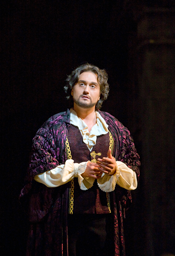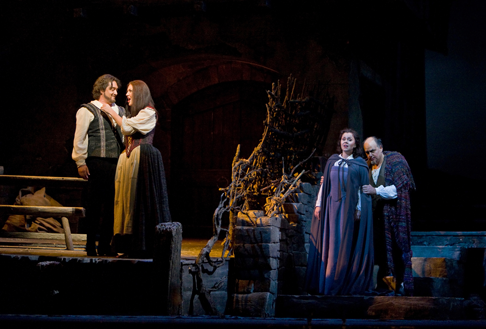25 Feb 2009
Rigoletto at the MET
The Plague of Beautiful Sounds: Has Bel Canto gone too far?

The Plague of Beautiful Sounds: Has Bel Canto gone too far?
The term Bel Canto, historically associated with operatic singing, is essentially easy to define; however, as of late it has come to represent something other than its initial connotation. “Beautiful Singing,” is not simply the manifestation of a beautiful sound, but an actual aesthetic singing method that has been passed along from its early masters to those singers who choose to execute it. But, have we become obsessed with the “beautiful sound” rather than the aesthetic concept of Bel Canto? Is making beautiful sounds enough to ensure the verisimilitude of Opera?
On February 4th , the performance of Rigoletto at the Metropolitan Opera began with an announcement that on the eve prior Italian tenor, Giuseppe Filianoti, had spontaneously filled in for Mr. Rolando Villazón in the role of Edgardo in Lucia di Lammermoor, opposite Anna Netrebko. A significant feat for any well-seasoned professional, the announcement that Filianoti would sing back-to-back performances and continue with his scheduled performance as the Duke in Rigoletto was met with much applause.
 Giuseppe Filianoti as the Duke
Giuseppe Filianoti as the Duke
Debuting with Rigoletto, young Italian conductor Riccardo Frizza
handled the Metropolitan Orchestra well, if perhaps lacking some of the
necessary vibrancy required of Verdi’s scoring. At times, the
tempi were held much too strictly and were devoid of
rubato, that when used tastefully in middle-period Verdi can assist
singers in carrying out pure Bel Canto singing. While tentative at
first, Maestro Frizza settled into a more dramatically charged orchestral
character by Act III. The swells in the storm scene, however, could have been
more substantial, especially in a scene where Verdi employs the use of the
human voice as a natural device, the howling wind of the storm. Chorus
Master, Donald Palumbo was magnificent in his direction of this chorus that
was the foundational support of the production.
 George Gagnidze (Rigoletto)
George Gagnidze (Rigoletto)
Georgian Baritone, George Gagnidze, whose singing was the most accurate,
aesthetically pleasing, and dramatic was promising in his portrayal of
Verdi’s hunchback. His Rigoletto was both pathetic and sometimes sinister
in his vendetta. In scenes his with Gilda, portrayed by Polish Soprano,
Aleksandra Kurzak, the dramatic effectiveness of his singing faltered and
several scenes became stagnant, if not all sounding the same. Gagndize began
to tread the line between reality and the other in Act III, with his most
dramatic singing and acting at the point when Gilda is discovered in the
sack. A lovely, baritone with colore brucciato, Gagnidze carried the
brunt of this production on the merits of his talent.
Soprano, Aleksandra Kurzak possessed a beautiful, clear voice, if not too clear for Verdi. Because Gilda is young, she is often portrayed by a coloratura lirica; historically however, Verdi’s orchestral palate and the dramatic penchant of his writing would require a fuller voice that is capable of high tessitura and yet broad enough in the middle registers to mesh with the orchestral thickness of Verdi’s middle-period writing. Ms. Kurzak’s voice was even soubrette-like and much too light in contrast to Filianoti’s full dramatic tenor and Gagnidze’s burnished Baritone. Her Caro Nome left much to be desired. Unfortunately, Maestro Frizza was not helpful; almost painfully strict, he did not allow any semblance of stretching, rubato, or colorito. In fact, it resembled early Mozart more than a middle-period work of Verdi. If a voice of this type were to sing Gilda, it would be to implement the bell-like quality of the notes in the higher tessitura; however, Ms. Kurzak lacked squillo in her upper range, presenting her with difficulty in the final fioriture of Gilda’s cadenza. Unfortuantely, she also lacked fullness in her middle register, a likely cause why Mr. Gagdnize’s scenes with her affected his own vocal colour. While producing some lovely sounds throughout, dramatically Ms. Kurzak failed to add any electricity to this production.
 A scene from Rigoletto with Giuseppe Filianoti as the Duke, Viktoria Vizin as Maddalena, Aleksandra Kurzak as Gilda and Roberto Frontali in the title role of Rigoletto.
A scene from Rigoletto with Giuseppe Filianoti as the Duke, Viktoria Vizin as Maddalena, Aleksandra Kurzak as Gilda and Roberto Frontali in the title role of Rigoletto.
Mezzo-Soprano, Viktoria Vizin, was highly effective as Maddalena, exuding just the right amount of sultriness. She was dramatic and illuminated the stage perhaps more than her colleagues, and possesses a rich mezzo that is well suited to the Verdian palate.
While the majesty of the Met always remains, this production was not one of its most memorable. A young cast of promising talent is always exciting, however the shift in aesthetic understanding is equally noticeable. What would a Rigoletto have been like 40 years ago or even in 1851? Historically speaking, opera is an art of old and its aesthetic properties, even if set modernly by present-day artists, should remain as they were intended. Verdi’s hunchback is perhaps the character to whom he related the most for a number of reasons; yet, this production lacked the dramatic penchant that even one glance at the score makes blatantly evident.
“Careful,” might seem the word of the day. Taking the risk of making an audience believe that what is occurring on that stage is a reality in the midst of a larger one is becoming more and more sparse. Swallowed by the need to make a “beautiful sound,” the risk of dramatic intensity is flickering. Is removing the portamenti that are essential to Bel Canto, and singing strictly on the beat the way to create drama or remain historically accurate to Verdi’s aesthetic? If we continue to cater to the “beautiful sound” alone, the art of opera cannot remain true to its historical ancestry. It would be the desire of any spectator to hear a few sounds that were not as beautiful, at the behest of dramatic efficacy.
Mary-Lou Patricia Vetere © 2009